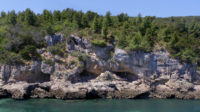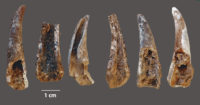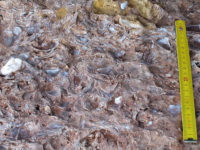A new study has found that contrary to popular belief, Neanderthals loved them some sea meats. Remains of marine foods are lacking at Neanderthal sites in Europe, whereas the anatomically modern humans living in Africa at the same time left behind extensive evidence of regular consumption of aquatic foods. Because marine foods are very high in Omega-3 fatty acids that aid in the brain development, this dietary disparity was thought to have played a role in how advanced cognitive skills grew among humans of modern anatomy and not in other archaic human species.
 However, absence of evidence is not evidence of absence, as the aphorism goes, and a great deal of coastal Europe was churned up in the last Ice Age by the growth and movement of icecaps and the rise of sea levels after their thaw. Gruta da Figueira Brava, a seaside cave 20 miles south of Lisbon, Portugal, on the other hand, was uniquely protected from erosion and submersion because of its position on a steep shelf off the Arrábida mountain range.
However, absence of evidence is not evidence of absence, as the aphorism goes, and a great deal of coastal Europe was churned up in the last Ice Age by the growth and movement of icecaps and the rise of sea levels after their thaw. Gruta da Figueira Brava, a seaside cave 20 miles south of Lisbon, Portugal, on the other hand, was uniquely protected from erosion and submersion because of its position on a steep shelf off the Arrábida mountain range.
Today the cave has three entrances in a cliff overlooking the water, but during the Last Interglacial period when Neanderthals lived there about 86,000 to 106,000 years ago, it was just over a mile from the sea. A team of international researchers led by João Zilhão from the University of Barcelona excavated the cave shelter and found clear evidence that the Neanderthal population regularly and thoroughly exploited marine animal resources.
 They ate crabs — brown and spider — an assortment of mollusks — limpets, mussels, clams — fish — sharks, eels, sea bream — seabirds — cormorants, egrets, gannets, auk — waterfowl — loons, mallards, geese — and marine mammals — dolphins and seals. The density of the remains is comparable to that found at African Middle Stone Age and Last Interglacial sites in Africa. It even exceeds the latter in terms of crab and fish.
They ate crabs — brown and spider — an assortment of mollusks — limpets, mussels, clams — fish — sharks, eels, sea bream — seabirds — cormorants, egrets, gannets, auk — waterfowl — loons, mallards, geese — and marine mammals — dolphins and seals. The density of the remains is comparable to that found at African Middle Stone Age and Last Interglacial sites in Africa. It even exceeds the latter in terms of crab and fish.
 Their gastronomic enjoyment of aquatic species was not exclusive. They also hunted hoofed game — deer, goats, horses, aurochs — and other small land animals like tortoises. Plants — olives, figs — were on the menu as well. They foraged extensively, storing mature pinecones to eat the nuts during the winter.
Their gastronomic enjoyment of aquatic species was not exclusive. They also hunted hoofed game — deer, goats, horses, aurochs — and other small land animals like tortoises. Plants — olives, figs — were on the menu as well. They foraged extensively, storing mature pinecones to eat the nuts during the winter.
Figueira Brava provides the first record of significant marine resource consumption among Europe’s Neandertals. Taphonomic and site-preservation biases explain why this kind of record has not been previously found in Europe on the scale seen among coeval African populations. Consistent with rapidly accumulating evidence that Neandertals possessed a fully symbolic material culture, the subsistence evidence reported here further questions the behavioral gap once thought to separate them from modern humans.